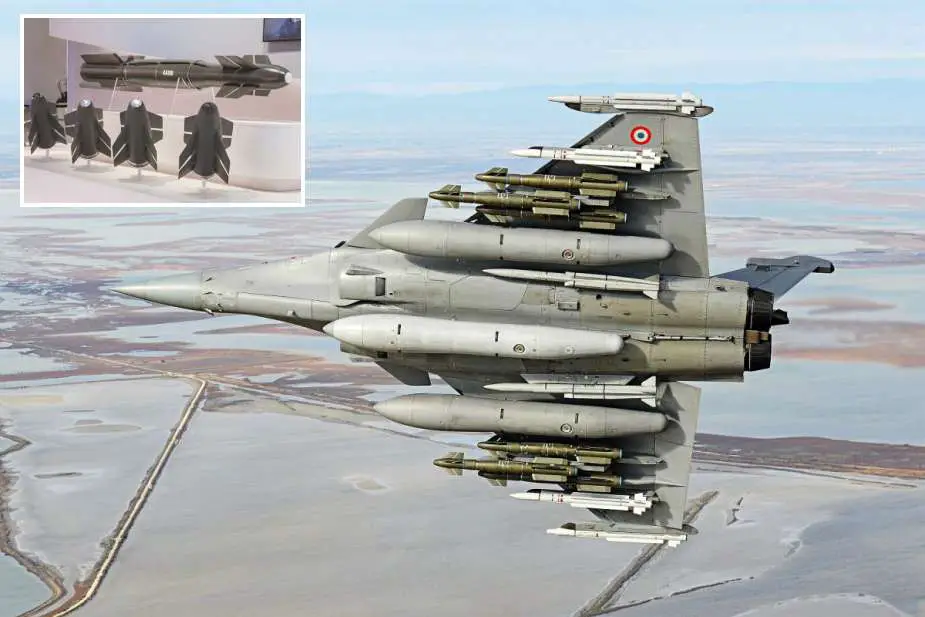France confirms delivery of 600 AASM guided bombs to Ukraine
On January 17, 2024, French Defense Minister Sébastien Lecornu announced during a press conference that France would deliver SCALP-EG missiles and AASM (Air-to-Ground Modular Weapon) guided bombs to Ukraine. This military assistance will include an initial batch of 40 SCALP-EG cruise missiles, followed by several hundred AASM bombs.
Follow Army Recognition on Google News at this link

The AASM Hammer system is compatible with various standard bomb bodies, including 125, 250, 500, and 1,000 kg. It is autonomous and immune to jamming, allowing it to be fired at low altitudes, even in rugged terrain (Picture source: Safran)
According to Minister Lecornu, the first batch of 50 AASM bombs will be shipped to Ukraine as early as January. These deliveries will continue every month, with the commitment to maintain this pace at least until the end of the year. This means that Ukraine will receive a total of nearly 600 of these advanced munitions, in addition to the SCALP-EG missiles, in line with President Emmanuel Macron's promise.
This contribution of armaments is considered a major asset for the Ukrainian Air Force, which seeks to increase its long-range strike capabilities and precision. The AASMs, known for their agility and extended range, will allow Ukraine to target distant objectives with greater accuracy, thus increasing their operational effectiveness in complex combat scenarios.
The AASM system, also known as HAMMER (Highly Agile Modular Munition Extended Range), is a notable technological achievement in the field of guided weapons. These French modular munitions are distinguished by their flexible architecture, allowing adaptation to various calibers and types of missions. Each AASM bomb consists of an unguided base body to which two key modules are added: a control module at the front, equipped with a satellite navigation system and/or a seeker head (infrared or laser), and a set of X-shaped stabilizers with rudders for increased maneuverability. The design also incorporates a folding wing to extend the bomb's range. This modular design allows for remarkable strike precision, with a circular error probable (CEP) of 8 to 10 meters for coordinate guidance and 1 to 3 meters when using a seeker head. The latest versions include a small solid propellant motor to further increase the flight range, reaching up to 50-70 kilometers or more. Initially based on the American-designed Mk 82 bomb, the AASM has evolved to include versions based on bombs ranging from 125 to 1000 kg calibers, thus demonstrating great versatility and adaptability to different operational needs.
Integrating the AASM bombs into the Ukrainian Air Force presents significant challenges. Firstly, material compatibility is a major concern. The AASMs were designed for Western combat aircraft like the Rafale, while the Ukrainian Air Force primarily operates Soviet or Russian-origin aircraft. This implies either modifying existing aircraft, a potentially costly and technically complex undertaking, or acquiring new compatible aircraft. Furthermore, training pilots and ground personnel is crucial for the effective use of these advanced weapons. Such training must cover not only the operation of the bombs themselves but also their integration into the aircraft's mission and targeting systems.
Besides the technical and logistical challenges, the use of AASMs by Ukraine must take into account the strategic reality of the conflict. Advanced Russian anti-aircraft defenses, capable of detecting and intercepting targets such as guided bombs, pose a significant risk to the effectiveness of these munitions. The AASMs, although precise and capable of reaching distant targets, may be vulnerable to countermeasures and interceptions. Moreover, each mission involving the use of these bombs exposes Ukrainian aircraft, often limited in number, to increased risk against a well-equipped adversary. These factors must be carefully weighed to assess the real impact of integrating AASMs into the Ukrainian arsenal.
The French AASM bombs, known for their precision and versatility, are currently used by several countries, including France, Egypt, India, Qatar, and Morocco. In all these cases, the aircraft of choice for deploying these munitions is the Dassault Rafale, an advanced combat aircraft designed for optimal integration and efficiency with the AASM. This preference for the Rafale raises an intriguing question: might France consider providing Rafale aircraft to Ukraine to accompany its AASM bombs, similar to their current commitment with SCALP-EG missiles? The successful adaptation of SCALP-EG missiles to Ukrainian combat aircraft, as demonstrated by the Ukrainian Air Force with its Su-24М tactical bomber equipped with the French SCALP EG cruise missile, suggests a Ukrainian capability to integrate advanced Western technologies. This demonstration during the Air Force Day of the Armed Forces of Ukraine on July 6, 2023, and the similarity with the adaptation of British Storm Shadow missiles, reveals a significant enhancement in Ukraine's military capabilities. The presence of Ukrainian President Volodymyr Zelensky, inscribing a message on a SCALP EG missile mounted on a Su-24М bomber, underscores the strategic importance of this new armament. This leads to the question of whether a similar adaptation of AASMs on existing Ukrainian aircraft is feasible, or if, to maximize the effectiveness of these weapons, France might consider providing Rafales to Ukraine, thereby significantly extending its military support.
- Hits: 3236
















